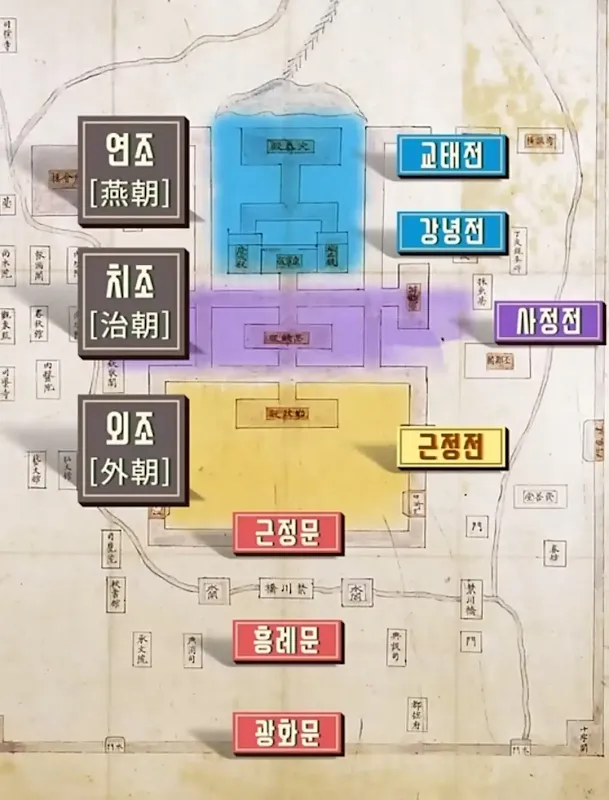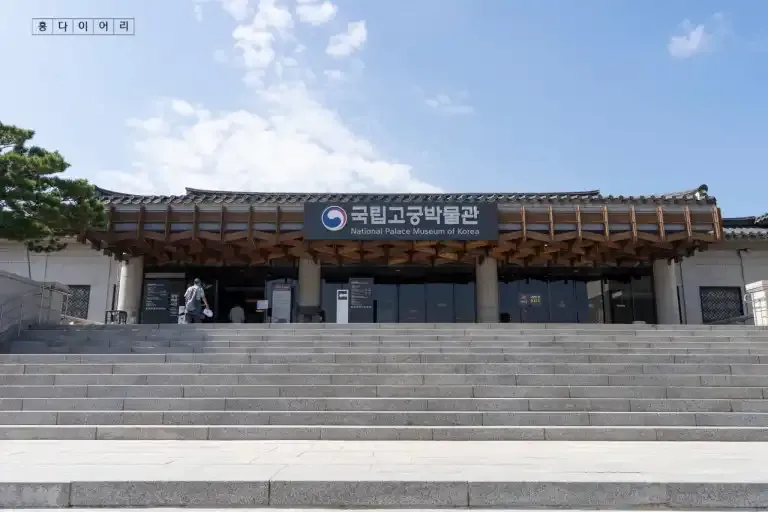

Gyeongbokgung Palace is a representative tourist attraction where you can experience Korean history and culture. It is also a tourist attraction visited by many foreign tourists because of the beautiful harmony with Bukaksan Mountain behind the palace.
Seoul has always been an important region and capital throughout thousands of years of Korean history. In particular, it was the capital of Joseon, a nation before Korea, so much of Joseon’s culture and history remains.
Gyeongbokgung Palace had a great symbolic meaning in Joseon history. As the first palace of Joseon, it was an important space that contained the nation's governing philosophy and symbolic meaning beyond the simple royal residence. As a result, Gyeongbokgung Palace had a great influence on Joseon both politically and economically. A representative example is the incident in which an attempt to rebuild Gyeongbokgung Palace in the late Joseon Dynasty led to hyperinflation, which led to an economic crisis in Joseon. In addition, it also served as the background for historical events such as the 'Eulmi Incident'.
Even today, Gyeongbokgung Palace has a great significance, and in front of Gwanghwamun, the main gate of Gyeongbokgung Palace, there is Gwanghwamun Square, which runs between large roads and buildings. Various events and political rallies are held at Gwanghwamun Square. In 2016, during the rally demanding the impeachment of President Park Geun-hye, over a million citizens gathered at Gwanghwamun Square and participated in the rally.
Gyeongbokgung Palace was the first palace of Joseon, and along with Joseon's history, it was destroyed and restored. It was completely destroyed during the Imjin War, the biggest invasion of Joseon, and was not rebuilt for 200 years. It was rebuilt again in the late Joseon Dynasty. However, even this was mostly damaged by Japan during the Japanese colonial period. After liberation, it was restored little by little over a long period of time and is still being restored. However, it is regrettable that it is difficult to completely restore it because there is a lack of information on the appearance of Gyeongbokgung Palace in the old days.
Gyeongbokgung Palace is one of the most visited tourist attractions in Korea. It is the best place to experience Korean culture and is one of the most beautiful structures in Korean history. If you visit Korea, I highly recommend you visit it.
🕒Operating hours
January - February: 9:00 - 17:00
March - May: 9:00 - 18:00
June - August: 9:00 - 18:30
September - October: 9:00 - 18:00
November - December: 9:00 - 17:00
💲Admission Fee
Under 19: Free
19~64 years old: 3,000 won
*Free admission when wearing Hanbok.
Night Viewing
📅Period: April~May, September~October
🕒Opening hours: 19:00 ~ 21:30
Reservations are required for night viewing. However, if you are wearing a hanbok, you can enter without a reservation. Since making reservations for night viewing is difficult, if you are not familiar with Korean, it is recommended that you wear a hanbok and go to the night viewing. Also, since the schedule changes slightly every year, you can check the exact date at the link below. Copy and search for '경복궁 야간관람' to check the date.

If you go to Gyeongbokgung Palace wearing a hanbok, admission is free. You can also visit at night without a reservation. In addition, it will be a more meaningful memory if you wear Hanbok, the traditional Korean clothing, and tour the Korean palace. Many visitors wear Hanbok and tour Gyeongbokgung Palace. There are famous places around Gyeongbokgung Palace where Korean traditions remain, such as Seochon Village and Bukchon Hanok Village, so if you visit wearing Hanbok, your trip will be even more enjoyable.
There are many hanbok rental places near exits 3 and 4 of Gyeongbokgung Station. Since the prices are similar at each hanbok store, I recommend renting from a store that sells hanbok you like. The price for renting a hanbok is 20,000 won for 4 hours for a basic hanbok, and 30,000 won for the whole day. For more special and pretty hanbok, the price is higher, but if you are only wearing it once, I recommend wearing a prettier hanbok. There are many pretty hanbok that are worth the price, so please look carefully. You can also rent accessories and bags for an additional fee.

There are two main ways to visit Gyeongbokgung Palace.
1. Gyeongbokgung Station Exit 5: The fastest way if you take the subway
2. Gwanghwamun: Enter through Gwanghwamun, the entrance gate of Gyeongbokgung Palace.
It is a good idea to use Exit 5 of Gyeongbokgung Station, but since Gwanghwamun is a representative building that symbolizes Korean tradition along with Gyeongbokgung Palace, if you visit Gyeongbokgung Palace, we recommend visiting through Gwanghwamun.
There are many places around Gyeongbokgung Palace where you can experience traditional Korean culture. Area 1 in the photo is Seochon Village, Area 2 is Bukchon Hanok Village, and Area 3 is Gwanghwamun Square. If you are planning to visit Gyeongbokgung Palace, I recommend visiting these places together.

Gyeongbokgung Palace consists of three gates and three sections. The three gates are Gwanghwamun (강화문), Heungryemun (흥례문), and Geunjeongmun (근정문). After passing through the three gates, the first section is Geunjeongjeon (근정전), the second section is Sajeongjeon (사정전), and the third section is Gangnyeongjeon (강녕전) and Gyotaejeon (교태전). Further in, there are auxiliary buildings such as Hyangwonjeong (향원정) and Gyeonghoeru (경회루). In addition to the existing Gyeongbokgung Palace buildings, the current Gyeongbokgung Palace also houses the National Folk Museum and the National Palace Museum, allowing visitors to learn about Korean history.
 Gwanghwamun (강화문)
Gwanghwamun (강화문)
Gwanghwamun is the main gate of Gyeongbokgung Palace and is a representative cultural heritage of Korea where you can feel the dignity of the Joseon Dynasty palace. Gwanghwamun is a wooden building on a stone wall and gives off a very grand atmosphere.
 Heungryemun (흥례문), Geunjeongmun (근정문)
Heungryemun (흥례문), Geunjeongmun (근정문)
Hongnyemun Gate and Geunjeongmun Gate are the second and third gates leading into Gyeongbokgung Palace.

Between Heungryemun and Geunjeongmun, there is a bridge called Yeongjaegyo that crosses Geumcheon. Geumcheon is an artificial river that separates the king's space from the secular space. When you cross Yeongjaegyo, you can see a stone beast next to Yeongjaegyo. It is a stone beast called Cheonrok, and it is said that it appears when the king is good. Some Cheonrok are even wearing melongs.
 Geunjeongjeon (근정전)
Geunjeongjeon (근정전)
Geunjeongjeon is the building in the first district and was used to welcome foreign envoys and hold major events such as state ceremonies.

The interior of Geunjeongjeon is full of wooden structures, and the high ceilings allow you to see the beauty of the wooden building.
 Sajeongjeon (사정전)
Sajeongjeon (사정전)
Sajeongjeon is a building in the second district and is the king's office and where the king conducts his daily business.
 Gangnyeongjeon (강녕전), Gyo Taejeon (교태전)
Gangnyeongjeon (강녕전), Gyo Taejeon (교태전)
Gangnyeongjeon and Gyotaejeon are buildings in the third district and are the residences of the king and queen.
 Hyangwonjeong (향원정)
Hyangwonjeong (향원정)
Hyangwonjeong is a pavilion in the middle of a pond. What makes Hyangwonjeong so charming is that it shows different appearances each season. The Hyangwonjeong in the photo is in autumn, showing off its beauty with the red maple leaves. Hyangwonjeong is a representative photo zone of Gyeongbokgung Palace and is a great place to take pretty pictures.
 Gyeonghoeru (경회루)
Gyeonghoeru (경회루)
Gyeonghoeru is the largest pavilion in Joseon Dynasty and was used for holding royal ceremonies and entertaining envoys. The Gyeonghoeru in the photo is what it looks like at night. Surrounded by a pond, it has a very beautiful appearance.
 National Folk Museum
National Folk Museum
The National Folk Museum of Korea, located in Gyeongbokgung Palace, boasts a splendid exterior with a moon terrace and a wooden pagoda. However, the actual operating area is on the first floor and in the basement. It is a place where you can see Korean history and culture at a glance, so please visit.
 National Palace Museum
National Palace Museum
The National Palace Museum of Korea is a museum located at the entrance of Gyeongbokgung Palace. It is a museum where you can see the royal palaces and the kings' lives of the Joseon Dynasty.

Gyeongbokgung Palace is very large and has a lot to see, so I recommend that you follow the tour route in order. I will explain based on the numbers on the map.
1. Reinforcement Gate (강화문): First, enter Gyeongbokgung Palace through Gwanghwamun. Once you pass through Gwanghwamun, there is a ticket booth on the right. If you are wearing hanbok, you can go straight to the ticket booth, but if you are not wearing hanbok, you must purchase a ticket.
2. Geunjeongjeon (근정전): If you have purchased a ticket, go through Heungryemun and Geunjeongmun to Geunjeongjeon.
3. Gangnyeongjeon (강녕전): Turn right of Geunjeongjeon and go back to arrive at Gangnyeongjeon.
4. National Folk Museum: After passing Gangnyeongjeon, go to the right to get to the National Folk Museum. There is also a children's museum.
No. 5 Hyangwonjeong (향원정): After visiting the National Folk Museum, go to the left and you will see Hyangwonjeong.
Route 6 Gyeonghoe-ro (경회루): If you go back down after going around Hyangwonjeong, you will find Gyeonghoeru.
7. National Palace Museum: If you go down Gyeonghoeru, you can see the National Palace Museum. After you finish, you can go back to Gwanghwamun, or if you want to take the subway, you can go straight to Exit 5 of Gyeongbokgung Station.

During the Joseon Dynasty, the Gyeongbokgung Palace had a guard of honor and royal bodyguards. This has now been recreated, with the guards taking turns guarding the gates.

The Gyeongbokgung Palace Royal Guard Changing Ceremony is a representative traditional cultural event that symbolizes the royal guard culture of the Joseon Dynasty. It is a ceremony that takes place twice a day for about 20 minutes and is a great attraction for tourists.
📅Event Days: All days except Tuesday (cancelled in case of rain)